SPIDER PATIENCE

Frequently Asked Questions
-
Is Spider Patience the same as Spider Solitaire?
Yes! Spider Patience and Spider Solitaire are two names for the same game. 'Patience' is the traditional British term for solitaire card games.
-
How many cards are used in Spider Patience?
Spider Patience uses 104 cards from two standard 52-card decks. All jokers are removed before play.
-
What's the best difficulty level to start with?
Begin with 1 Suit Spider Patience, which has approximately a 50% win rate. Once comfortable, progress to 2 Suits, then challenge yourself with 4 Suits.
-
Can I win every game of Spider Patience?
No, not every deal is winnable, especially in 2 and 4 Suits modes. The game involves both skill and luck, and some deals are mathematically impossible to solve.
-
How long does a game of Spider Patience take?
A typical game takes 10-20 minutes, varying by skill level and difficulty mode. 4 Suits games may take longer due to increased complexity.
-
Can I play Spider Patience on mobile devices?
Yes! Spider Patience works perfectly on mobile phones, tablets, and desktop computers. Play anywhere with an internet connection.
-
What happens when I complete a sequence in Spider Patience?
When you build a complete sequence from King to Ace in the same suit, it automatically moves to the foundation pile and is removed from the tableau.
-
How can I improve my Spider Patience win rate?
Practice regularly, prioritize revealing face-down cards, create empty columns strategically, build in-suit sequences, and think several moves ahead before acting.
-
Is there a time limit in Spider Patience?
No! Spider Patience has no time limit. Take as long as you need to plan your strategy and make the best moves.
-
Is Spider Patience good for brain training?
Yes! Spider Patience improves logical thinking, planning skills, concentration, pattern recognition, and patience. It's an excellent mental exercise for all ages.

